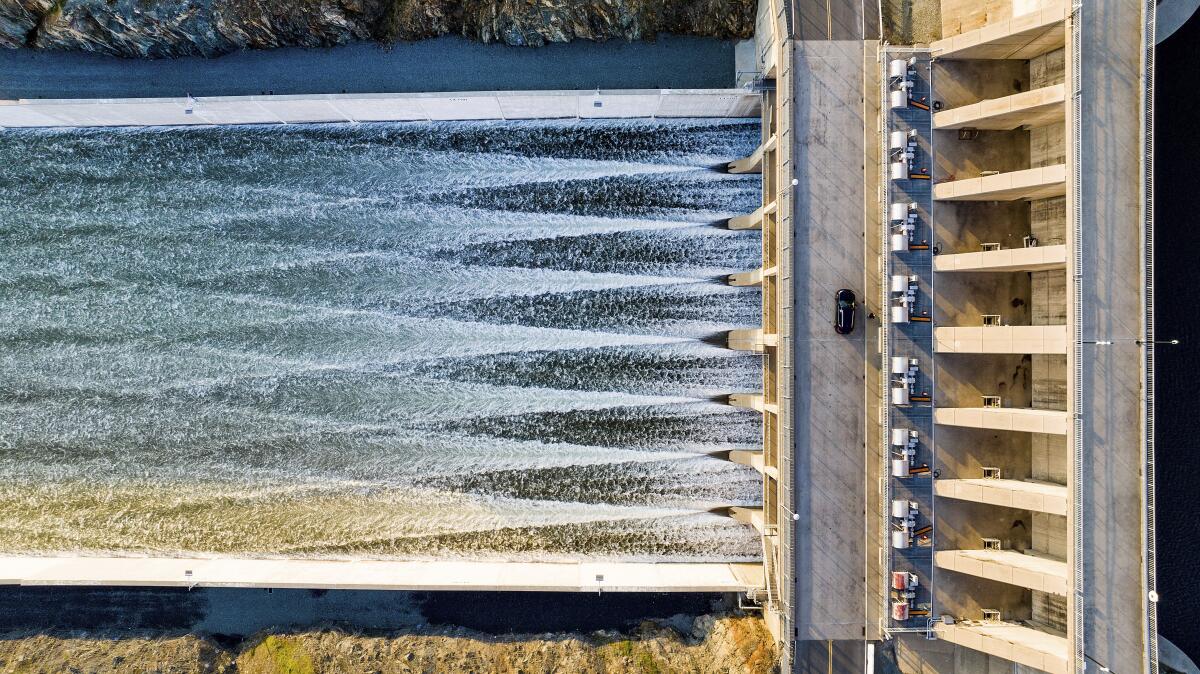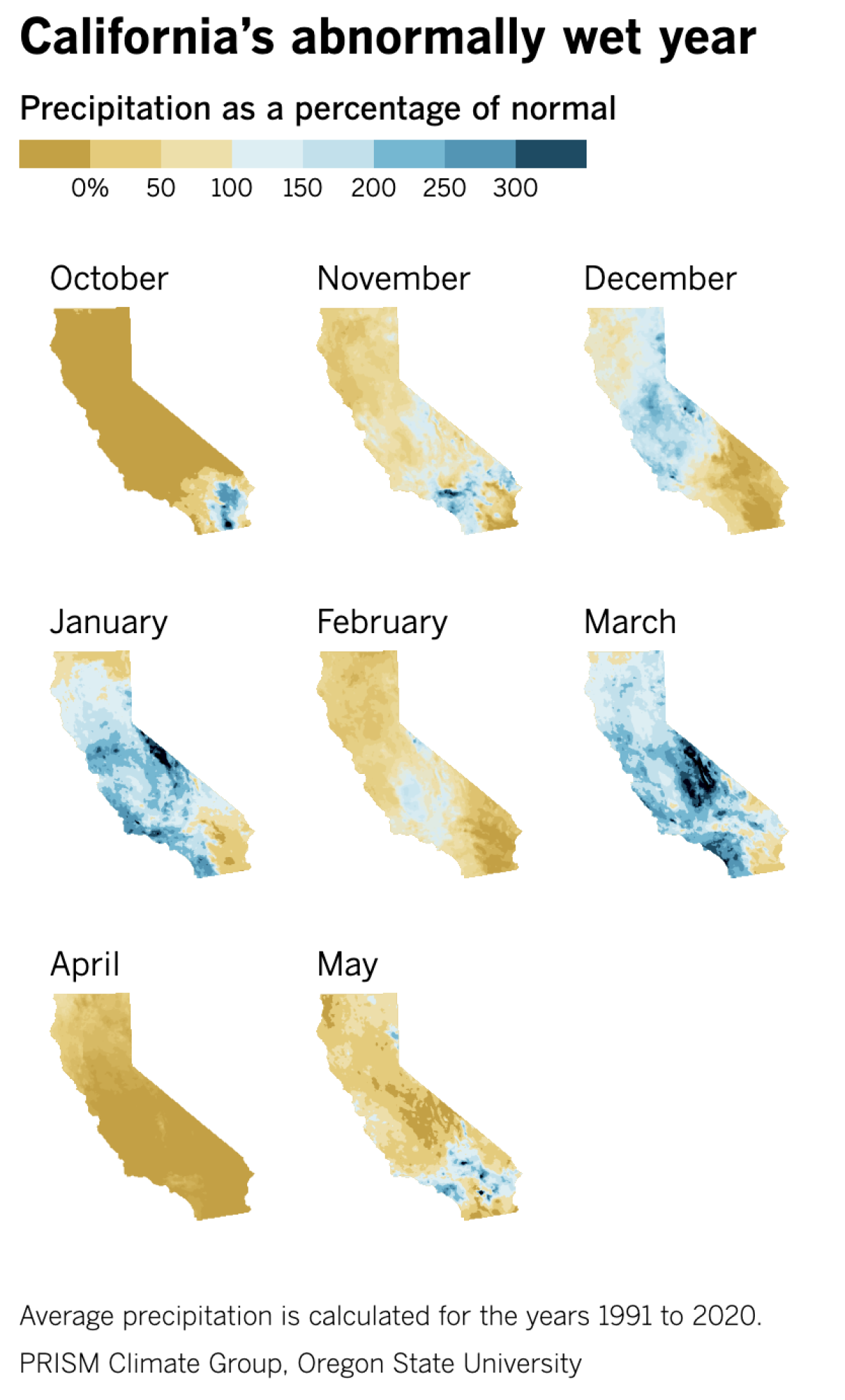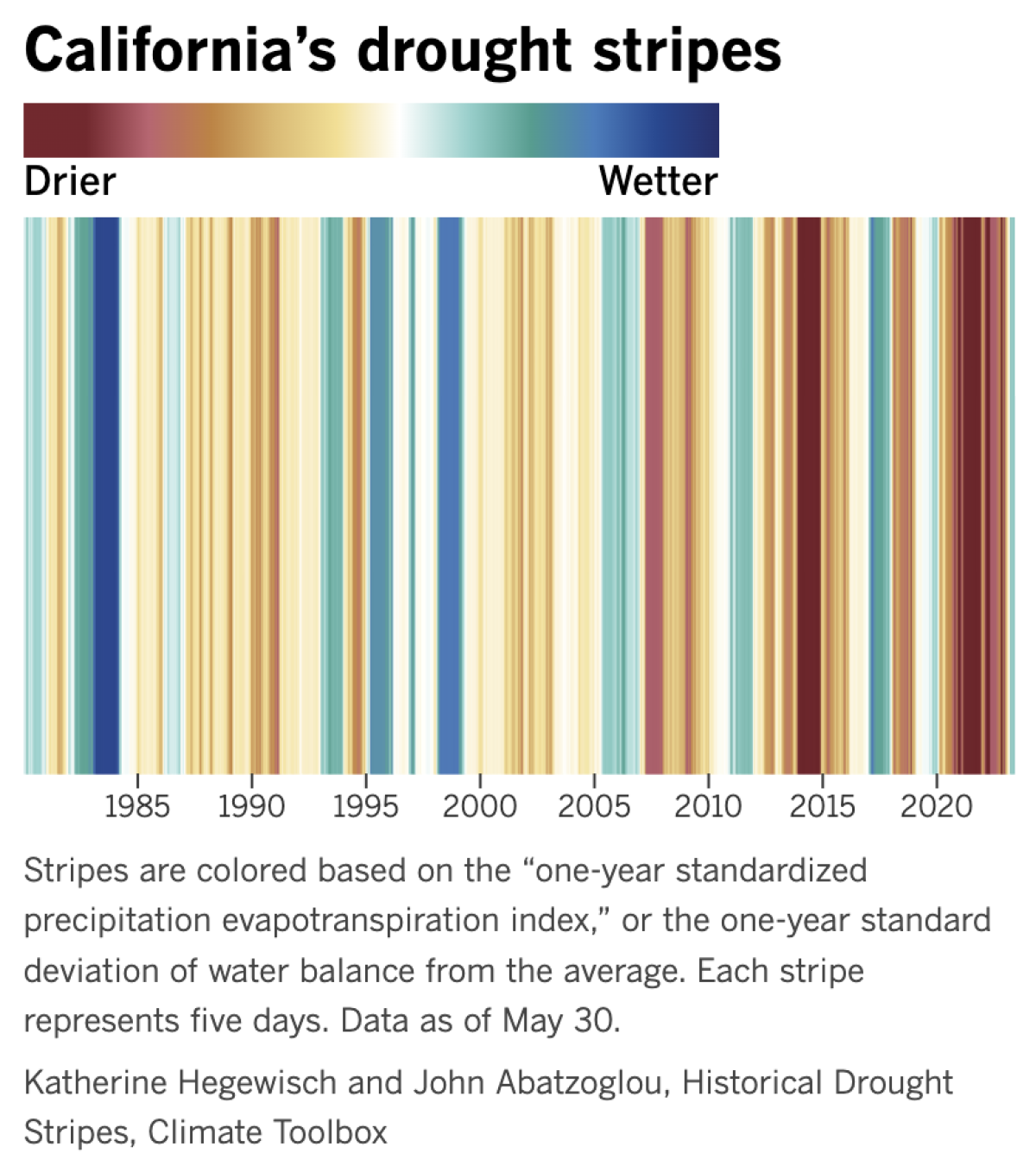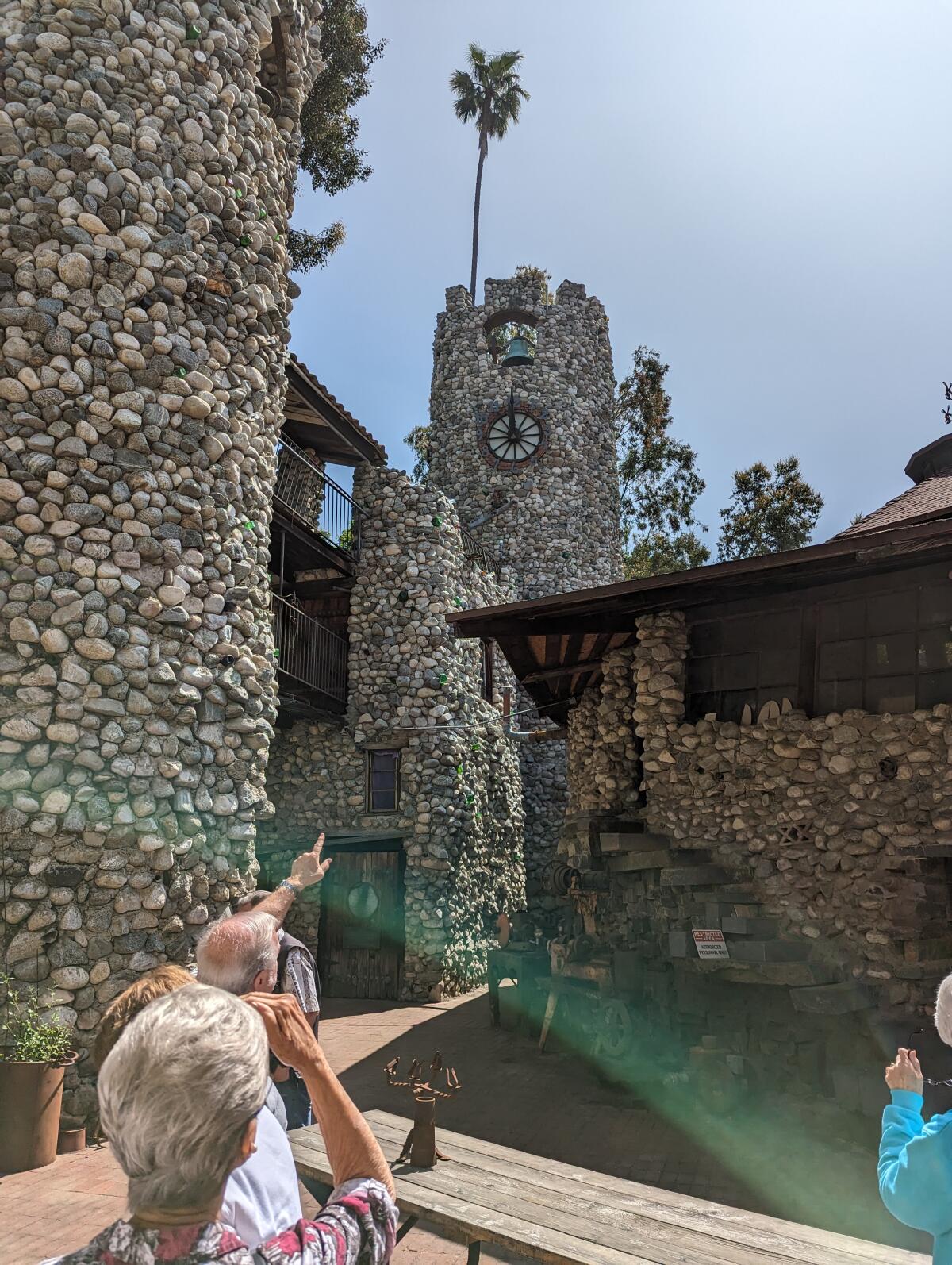What the data says (and doesn’t say) about drought

- Share via
Good morning, and welcome to the Essential California newsletter. It’s Monday, June 12. I’m Sean Greene, an assistant editor in the Data and Graphics department.
Do you remember when it started raining in California? I don’t really. All I remember is it seemed to keep coming. That is, until I look back at the data.
Last winter’s months-long parade of atmospheric rivers brought roughly 30 inches of rain and, importantly, snow to our drought-parched state. The downpours also brought a big question: Is the drought over?
I called some experts as the wet season peaked in April, to ask. They all said pretty much the same thing: For now.
“Drought is a tricky word because it means so many things to so many people,” said Benjamin Hatchett, an assistant research professor at the Desert Research Institute.
The meaning of drought depends largely on what the water is being used for or where it is. Is it the absence of rain? Or is there not enough water to grow crops or sustain cities?
Precipitation maps of the state show an abnormally wet winter, one that indeed broke the dry spell, albeit on a surface level. Even when drought conditions ease in California, the state’s long-term struggles with water scarcity and complex water challenges remain.

The storms helped to replenish many of the state’s major reservoirs, which last summer dipped to below half capacity, and revived the Sierra snowpack. Around mid-April, the mountains held about 40 million acre-feet of water, nearly as much as the total capacity of all the state’s reservoirs combined.
We’re now watching the enormous snowpack slowly melt and provide water through the rest of the state’s dry season.
But one wet year is not enough to overcome the long-term deficits brought on by such a severe dry period.
Climate whiplash
Long-term drought trends show that California has always fluctuated between years of intense drought and wildly wet years.

The graphic above shows the intensity of droughts (darker red stripes) and wet periods (blue stripes) and their durations since 1980, using data provided by UC Merced’s Climate Toolbox. On their website, you can generate drought stripes for your own area.
Each stripe represents five days, colored based on a one-year change in the state’s water balance (essentially the difference between precipitation and the evaporative demand of plants). You can see this winter’s effect essentially lifting the state out of “drought.” But it hasn’t been enough to level the long-term imbalance toward dry conditions. You’ll notice that since 2010, there are way more red and orange lines than blue and green ones.
“The word drought is not detailed enough,” said Katherine Hegewisch, the UC Merced project scientist who created the drought stripes tool. “It’s not detailed enough for people to understand that, temporarily, they can have a lot of water, but maybe it just goes off the surface. The soil moisture is not going to be replenished enough to help their agricultural drought.”
What we do know is that droughts are changing. The West is getting hotter and more arid.
When I helped build The Times’ drought tracker a year ago, I did not expect to see the U.S. Drought Monitor maps wear any color besides dark red.
For now, at least, that has changed. We revised our tracker to show reservoir levels over the last year so we could better observe how our water supply is changing. We will keep reporting as all the snow melts from the mountains until the cycle begins again.
Data, Hegewisch says, can help us remember. It helps us look back to a time when “hot and dry” seemed permanent, or the May gray endless.
“We’ve had periods in the past where we’ve had something similar,” Hegewisch said. “We can look back and remember how we survived.”
And now, here’s what’s happening across California from Essential California editor Laura Blasey:
Note: Some of the sites we link to may limit the number of stories you can access without subscribing.
L.A. STORIES
This year, Pride Month comes amid a volatile national backlash against LGBTQ+ people, including conservative lawmakers’ efforts to ban drag shows and restrict the rights of transgender people, and outcry against brands for marketing to queer people. But at Southern California’s Pride parades, LGBTQ+ Angelenos remain determined to “show our joy to the world.” Los Angeles Times
POLITICS AND GOVERNMENT
Officials will consider a proposal to ban homeless encampments from public property in San Diego this week and controversy is expected, with some cheering it as long overdue and others criticizing the idea as cruel and ineffective. The proposed ordinance would prohibit people from camping on public property if shelter options are available. San Diego Union-Tribune
Migrants say Florida contractors pushed to get them to board the California-bound planes that arrived in Sacramento last week. Migrants told The Times that a small group of unidentified people recruited them “aggressively,” promising lodging, legal help and even additional travel arrangements if they agreed to get on the chartered flights. “She told us not to be afraid — that she didn’t want to steal our hearts or our organs or anything,” one woman said. Some turned the group down, finding the offers suspicious. Los Angeles Times
CRIME, COURTS AND POLICING
In another historic indictment, former President Trump was indicted on 37 charges including Espionage Act violations in federal classified records case. The 49-page indictment, released Friday by the Department of Justice, details accusations that he stored classified documents at his Florida estate, including in a bathroom and shower. Among the top-secret and other classified records were details on foreign nations’ nuclear capabilities, as well as information regarding U.S. nuclear programs, potential vulnerabilities of the U.S. and its allies to military attack, and plans for possible retaliation in response to an attack. Los Angeles Times
Support our journalism
HEALTH AND THE ENVIRONMENT
How much water did California save during the drought emergency? In July 2021, Gov. Gavin Newsom asked urban water users to cut back by 15%. We crunched the numbers and found Californians largely missed the mark, but officials say the numbers belie the true progress the state has made on water conservation. Los Angeles Times
Wildfires forced this animal sanctuary out of California. But smoke found them in their new home too. Last year, Nate Salpeter and his wife, Anna Sweet, moved their animal sanctuary from California to western New York in the hopes of better protecting the health of the creatures in their care. But last week, massive wildfires burning in Canada sent huge plumes of ash across the northeastern U.S. Los Angeles Times
CALIFORNIA CULTURE
What would you do with 1 million pennies? If you have any ideas, this Inland Empire Realtor would like to know. John Reyes and his wife discovered the stash of coins while cleaning out the basement of her father’s former home in the Pico-Union neighborhood of Los Angeles. Getting rid of them has proved to be the real challenge. KTLA
Free online games
Get our free daily crossword puzzle, sudoku, word search and arcade games in our new game center at latimes.com/games.
AND FINALLY
Today’s California landmark is from Michael Sedlar of Walnut, Calif.: Rubel Castle in Glendora.

Michael writes:
There is a castle right in the middle of a residential neighborhood in Glendora! This landmark was built by Michael Rubel on the land owned by his parents. The history of the place includes the early days of the fruit picking and packing industry and later days of castle construction and fraternity. The Glendora Historical Society now owns the place and offers guided tours that are fascinating.
What are California’s essential landmarks? Fill out this form to send us your photos of a special spot in California — natural or human-made. Tell us why it’s interesting and what makes it a symbol of life in the Golden State. Please be sure to include only photos taken directly by you. Your submission could be featured in a future edition of the newsletter.
Please let us know what we can do to make this newsletter more useful to you. Send comments to [email protected].
Sign up for Essential California
The most important California stories and recommendations in your inbox every morning.
You may occasionally receive promotional content from the Los Angeles Times.




